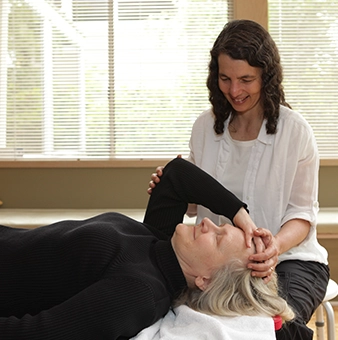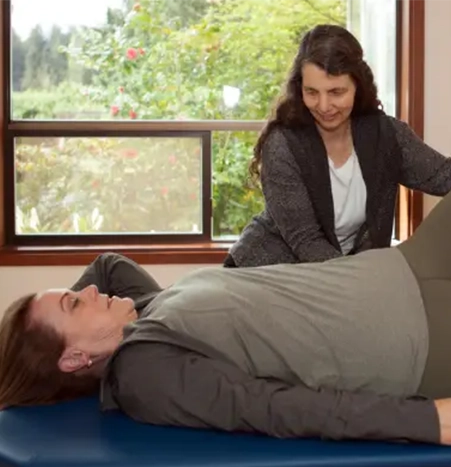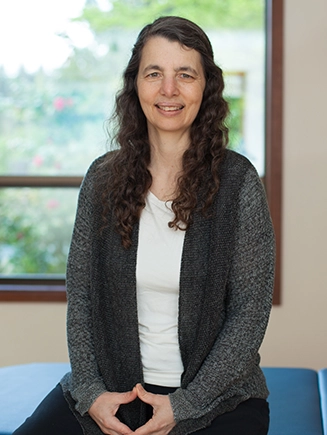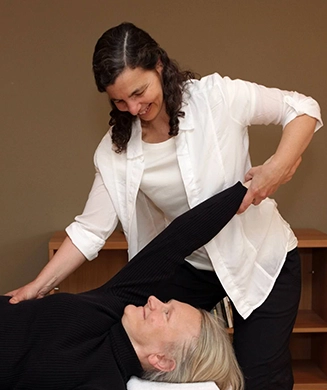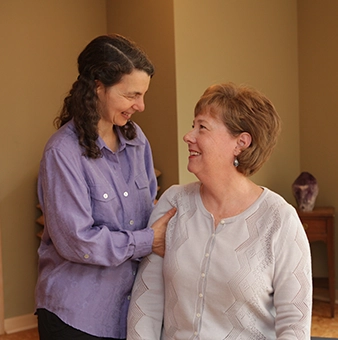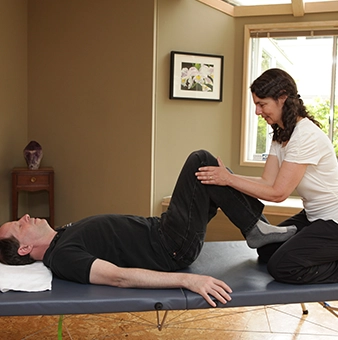Introduction to Feldenkrais Therapy
If you need chronic pain management or improved mobility, consider working with a certified Feldenkrais therapist. The Feldenkrais Method® is a form of somatic education that uses gentle movements to increase physical awareness. It helps people move with intention and reduce the stress on their joints and muscles.
A rehabilitation specialist at Kinetic Inquiry addresses your personal goals and challenges throughout the process. When you find a physical therapist who uses the method, it can improve outcomes and provide longer-term results.
Experience the Benefits of Feldenkrais Physical Therapy: Reduce Pain, Improve Posture, and Enhance Movement
Feldenkrais Therapy can help. Whether you’re dealing with chronic pain, recovering from an injury, or seeking to enhance your physical performance, Feldenkrais offers a gentle, effective approach.
Feldenkrais Therapy improves movement. It increases self-awareness. It reduces pain. Unlike traditional medical therapies, I won’t diagnose you or treat specific medical conditions. Instead, I’ll help you explore and refine your movement. Better movement means less stress on your muscles and joints. This helps your body heal and lets you get back to doing the activities you love and bring you joy.
Movement is part of every moment in your life. It is part of every breath, every step, and every gesture. So, the best part is that improving how you move improves your life. My clients report not only physical improvements but also enhanced mental clarity and emotional well-being.
Guild Certified Practitioner
Laura Yedwab
Guild Certified Practitioner
The Role of a Feldenkrais Therapist
Feldenkrais physiotherapy is a form of mobility restoration that guides clients through various movement sequences to improve their habits and increase awareness. Its practitioners have a responsibility to provide somatic therapy without increasing the risk of further damage or delaying healing.
What training does a provider receive for Feldenkrais treatment? The certification process requires about 800 hours of education and practice over the course of three or four years. It includes the following elements:
- They learn how to integrate Feldenkrais therapy into individual sessions and group classes.
- A mentor supervises as they improve body alignment with gentle and intentional movements.
- Educational topics include neuroplasticity training and knowledge about anatomy, psychology, and kinesiology.
Book A Free Consultation
In your free 60-minute consultation with your Feldenkrais practitioner, you will explore your goals and challenges, and identify specific movement patterns that are causing you problems. You will discover how we can work together to improve your movement so that you put less stress, wear and tear on your body.
Benefits of Feldenkrais Physical Therapy
and Feldenkrais Treatment
What are the benefits of Feldenkrais therapy and treatment? Working with a Feldenkrais therapist can provide the following advantages:
Improved flexibility: The therapy often yields an improved range of motion and works effectively for athletes and senior citizens.
Better pain reduction: Work with certified Feldenkrais therapists to reduce pain associated with multiple sclerosis, arthritis, and other conditions.
Reduced stress: The mindfulness practices used in the treatment can help reduce stress levels in your daily life.
Enhanced posture: Improper posture can cause chronic pain and long-term health problems. This method helps patients sit and stand without complication.
Improved mental health: Because the therapy takes a holistic approach to health, it may make a person more resilient to anxiety, depression, and other mental health complications.
Working with a client
What Happens During Feldenkrais Therapy Session?
What does a Feldenkrais therapy and treatment entail?
A one-on-one Feldenkrais session is called a Functional Integration session. During Functional Integration® sessions, you’ll work individually with a practitioner who can tailor the work to your specific needs and objectives.
Sessions typically are 60 minutes long. The client is always fully dressed. The goal is to bring a deep awareness to the client’s movement patterns so that they can learn to move with more comfort and ease. The practitioner uses gentle, non-invasive touch and movement to help the client sense their own movement patterns and learn new ones.
Can Feldenkrais Treatment Help You Move Better?
Absolutely! Anything we learned to do, we can improve.
In our culture, people often improve their movement skills for sports, music, and dance. For example, the National Golf Foundation estimated that in 2019 American citizens spent over a billion dollars on golf lessons!
Unfortunately, many people assume that their basic movements, like reaching and walking, are innate and unchangeable. However, these movements are learned skills that can be refined and improved. As babies, we had to learn how to reach and walk. However, since we don’t remember this learning process, we often don’t realize that we can continue to improve these skills.
Infants don’t perfect their ability to move. Instead, they reach a “good enough” level and then move on to learning other things, like social skills and math. Unfortunately, as we age, face injuries, or develop chronic pain, the skills we acquired in infancy may no longer be adequate. Pain is often our body’s way of saying it’s time to update our movement skills.
Feldenkrais Therapy provides a means to improve these skills.
A Child Learning to Walk
Laura Playing Racquetball
My Experience With Feldenkrais Therapy
After leaving my job at Microsoft, I fell in love with racquetball. Unfortunately, I kept straining my hamstrings—making walking painful.
I worked with several physical therapists for over two years. They all agreed that my glutes were weak and that my hamstrings were doing too much of the work. They prescribed exercises to strengthen my glutes. I did the exercises daily. But no matter how much I strengthened my glutes; my movement patterns stayed the same. On the court, I kept overusing my hamstrings. Though feldenkrais physical therapy was helpful, it was not enough.
Finally, a friend convinced me to try Feldenkrais therapy. After only a few sessions, I noticed improvements. I discovered how to engage my glutes while playing and they became stronger. Since I stopped overusing my hamstrings, they were able to recover. My movements became more powerful, fluid, and graceful. And I was winning more games!
Even after my hamstrings stopped being an issue, I continued with Feldenkrais Therapy. My posture, fluidity, and overall sense of well-being improved. I was deeply inspired. I joined a four-year program to become a certified Feldenkrais practitioner. I love sharing what I have learned with my clients.
What are the Principles of Feldenkrais Therapy?
Feldenkrais Therapy utilizes seven principles:
- Movement is essential for life. Every interaction we take in the world involves movement. For example, breathing, speaking, looking, eating, reaching, and walking are all movements.
- The brain can change and heal. Feldenkrais Therapy leverages our brain’s neuroplasticity, i.e. its ability to reorganize itself by forming new neural connections.
- Learning needs to be specific. Feldenkrais Therapy recognizes that each person’s body and movement patterns are unique and allows individuals to explore the specific movements patterns that are causing them difficulties.
- When we move better, we feel better. Even small improvements in movement can lead to significant benefits such as increased vitality, improved comfort, reduced anxiety, less pain, greater freedom, and a greater sense of well-being.
- Feldenkrais therapy teaches us to move better. Many techniques are used, but the most important is improving our awareness of how we move. We can’t change what we are unaware of. Once we can perceive the subtle details of our movement patterns, we can explore different approaches, and then discern which option provides greater ease, grace, and efficiency.
- Anything we learn, we can improve. Our minds are learning machines. Given the right learning environment, we can refine any skill.
- We learned to move. Most animals can walk shortly after birth. However, humans learn to move gradually. Babies spend their first-year learning to hold up their head, roll, sit, stand, and then finally walk. As adults, we tend to take these abilities for granted. But the fact is, they were learned skills.
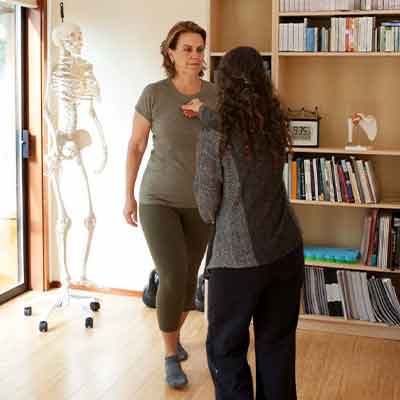
Integrating Feldenkrais With Physical Therapy
A certified Feldenkrais therapist can integrate the technique with physical therapy. Feldenkrais Seattle seeks to improve the outcomes of the treatment by guiding the patient through habits to use at home and support their holistic health objectives.
Is this form of physical therapy and treatment effective? Evidence from quality scientific studies remains limited. However, some meta-analyses and a consistent number of case studies show that the method consistently provides benefits to patients when used in conjunction with physical therapy.
One analysis provided by the University of Valencia shows that it improves treatment results for the elderly and people with chronic pain. Feldenkrais physiotherapy practitioners continue urging scientists to conduct more studies on the topic.
Feldenkrais vs. Other Modalities
It’s easy to wonder how Feldenkrais stacks up against other therapies. It’s not about being ‘better’ but understanding the differences. Think of it as choosing the right tool for a specific job. Some methods focus on strength, others on stretching, while Feldenkrais zeroes in on awareness and learning.
Feldenkrais vs. Physical Therapy
Physical therapy often targets specific muscles or joints to improve strength and range of motion. It’s great for post-surgery rehab or addressing acute injuries. Feldenkrais, on the other hand, looks at the whole movement pattern. It’s about retraining your nervous system to move more efficiently. Instead of forcing a muscle to work harder, it helps you find easier ways to move. neuroplasticity to improve movement and function.
Feldenkrais vs. Chiropractic
Chiropractic focuses on the alignment of the spine and its impact on the nervous system. Adjustments are used to correct misalignments. Feldenkrais also addresses the nervous system, but through movement. It’s less about forceful adjustments and more about gentle exploration. Think of it as:
- Chiropractic: Resetting the structure.
- Feldenkrais: Retraining the movement.
Feldenkrais vs. Yoga/Pilates
Yoga and Pilates are movement practices that emphasize strength, flexibility, and body awareness. They can be great for general fitness and well-being. Feldenkrais shares the focus on awareness, but it’s more individualized and adaptable. It’s not about achieving a specific pose, but about finding your own optimal way of moving. Plus, it’s often used in rehabilitation.
Feldenkrais isn’t about pushing your body to its limits. It’s about understanding your limits and expanding them gently through awareness and improved movement patterns. It’s a learning process, not a workout.
Feldenkrais vs. Massage Therapy
Massage therapy focuses on manipulating soft tissues to relieve tension and improve circulation. It can be great for relaxation and pain relief. Feldenkrais also addresses muscle tension, but through movement and awareness. It’s about finding the root cause of the tension, not just treating the symptoms. It’s like this:
- Massage: Releasing tension.
- Feldenkrais: Understanding why the tension is there in the first place.
- Feldenkrais: Learning how to prevent it from returning.
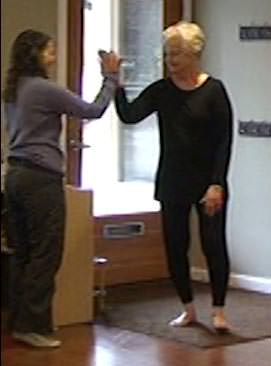
Choosing the Right Feldenkrais Therapist
Finding the right Feldenkrais therapist can improve outcomes and make the process feel more enjoyable. You should only seek this therapy method from a certified provider. You can double-check the practitioner’s status here.
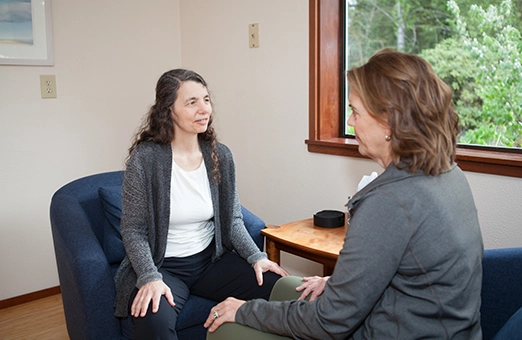
Also, consider asking the following questions:
- What is your background and training?
- How long have you had your certification?
- What expectations should I set for my outcomes?
- Which specific health goals and challenges can you address?
- What does a typical session look like?
- Do I need to bring anything or prepare in a specific way?
- How can you tailor the individual session to my needs?
- What happens if I have a disability or physical restrictions?
- When are group sessions, and are they mandatory?
- How can you support my health habits and goals between sessions?
Success Stories
When learning how Feldenkrais Therapy works, it is often beneficial to hear how it has helped others. Six of my clients have shared their stories of overcoming chronic pain, improving mobility, and enhancing their overall well-being.
For example, V. describes how she broke her back three times, was losing mobility, and felt like she was “on the verge of being disabled.” V. shares how she came to be pain free. Similarly, Kathy describes how her neck pain was interfering with her ability to work and how Feldenkrais Therapy helped her physically and emotionally heal.
To read these inspiring success stories visit the Success Stories page.

Working with a client
Schedule an Appointment for Feldenkrais
Physiotherapy Today
Feldenkrais therapy can improve your journey to holistic health by reducing pain and enhancing movement. At Kinetic Inquiry, you can work with a certified Feldenkrais therapist who cares about your challenges and goals. Schedule a free consultation for physical therapy and treatment by calling
425-202-5685 today.

